Deline
Délı̨nę
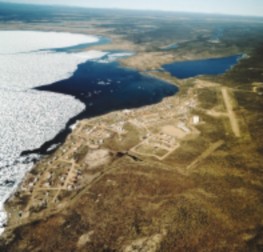

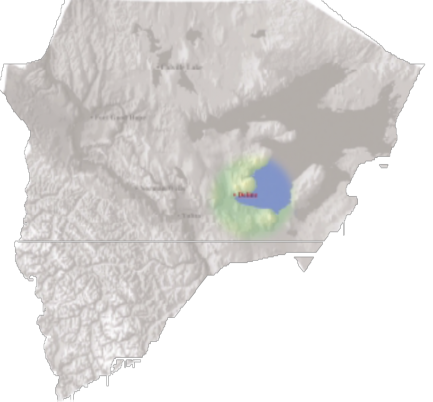
I Like Summer
by Wesley Kenny, Deline Mackenzie Valley Viewer, 2001
I like summer because of...
Going for boatrides...
or picking berries...
or going hunting...
Or playing soccer...
Or going to the bush...
Or going fishing...
Or going for a bike ride...
Or camping...
Or going for a trip to Yellowknife...
Or playing in the new playground...
Or playing kick the can at the church...
Or playing games at the old campground... ...With my friends.
Or playing boards with my friends...
Or playing football...
Or baseball...
Or taking jumps around with my friends...
Then we go to the Northern and buy pop... because we are thirsty.
Then we might play soccer again.
Deline, “where the water flow” is a community of about 650 people located on the west end of Keith Arm of Great Bear Lake/Sahtú, about 10 km from the outlet of the lake into the Great Bear River. It is a place thriving with wildlife. At one time, Deline was named after explorer Sir John Franklin, who built a fort there and used it as winter quarters during his second expedition in 1825-1827. The remains of the old fort were excavated in 1987. A letter from Sir John Franklin may have documented the first games of hockey at Fort Franklin in 1825, which he described as an enjoyable form of exercise for his crew.
Deline is also known as an important spiritual centre, birthplace of the prophet known as Ehtséo/Grandfather Ayha. Ehtséo Ayha’s life spanned 1858-1940, a critical period of contact with non-aboriginal outsiders. These included fur traders, missionaries, and opportunists seeking to profit from the rich radium/uranium pitchblende that was discovered on the east shore of Great Bear Lake in 1930. Ehtséo Ayha’s wisdom and prophesies are commemorated annually at a Spiritual Gathering in Deline attracting people from across the Northwest Territories, and as far away as Kugluktuk, Nunavut.
The trauma caused by the realization of the possible impacts of uranium mining on the land and people has been a catalyst for positive action by the Sahtúot’ine, the Dene people of Deline. In addition to reviving spiritual practices, the Sahtúot’ine have taken strong initiatives in researching the impacts of the mine, protecting the land and achieving self-government. As a result of hard work and years of persistence, the community succeeded in achieving the establishment of Grizzly Bear Mountain/Saoyúé and Scented Grass Hills/Ehdacho, Canada’s largest National Historic Sites in 1998. Deline is a leading community in the negotiation of terms for self-government.
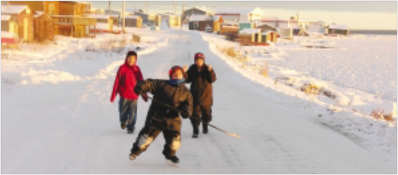
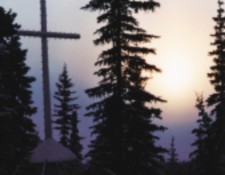
Deline youth © Robert Kershaw, 2004
Fort Franklin site marker © Morris Neyelle
Neregah / North Shore of Great Bear Lake
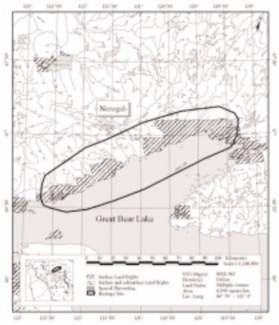
The north shore of Great Bear Lake (from McGill Bay, east to Greenhorn River) is a very important traditional use area, associated with many stories and named places. From the north shore Sahtu Dene gained access to caribou and musk ox hunting, and barrenlands trapping. Many of the stories talk of contact with the Inuit who were met inland, northward from the north shore. It is still used today as a traditional use area.
Sahtu Heritage Places and Sites Joint Working Group, Rakekée Gok’é Godi: Places We Take Care Of.
Deline To Kugluktuk Trip
Our first stop for the night was at the point of Ɂehdacho (Scented Grass Hills). The next stop was at the south shore of Ɂehdąı̨ı̨la (Caribou Point) where we spotted caribou, so we shot it and made fire for tea.
We had one problem on the way to Hornby Bay and that was one of the skidoos from Deline developing a mechanical problem. It was a good thing one of the visitors from Kugluktuk was an experienced skiddoo mechanic, because he fixed that skiddoo right on the spot.
Once we got on land, the visitors from Kugluktuk led the way and it seemed like there was no trail to follow because the trail wasn't going straight. The trip took a couple of overnight camps and one was at one of the many small cabins.
The return trip was a bit harder because the weather was turning warm and snow was starting to melt from the rocks. Most of the travellers from Deline were travelling with box sleds or fibreglass sleds from the store, and some of them broke apart easily from all the rocks. The people from Kugluktuk loaned some komatiks (Inuit sleds) to the visitors, and almost all their sleds had steel sliders.
The return trip was okay, until they got to the top of Æehdâîîla, where we could see Great Bear Lake. The trail barely had any snow. Whenever you mix steel and rock together, you would get a loud screeching sound and that means, you are not getting anywhere. And that's exactly what happened. Instead of a normal two hour trip to the lake, it took six or seven hours. By the time we got to the lake, it was two or three in the morning.
We arrive back in Deline the next day, safe and sound. Sahtu Heritage Places and Sites Joint Working Group, Rakekée Gok’é Godi: Places We Take Care Of.
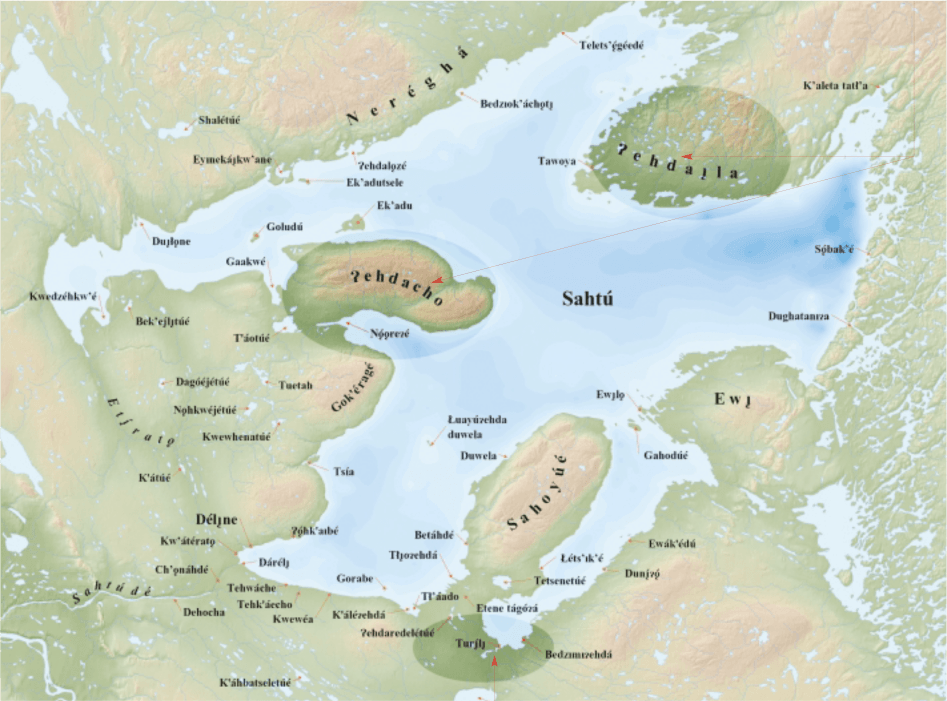
Deline Traditional Place Names project map
Turılı̨/ Johnny Hoe Fishery
An important place for the elders of Délı̨nę, Turılı̨ is known as a traditional domestic spring fishery, and is considered the traditional territory of the Turilı̨ Got'ine. Elders say that in the old days, at the mouth of the river, the Dogribs would begin building a fish weir from the east side, and the Slaveys from the west. When they met in the middle the event would be celebrated by a feast. Historically it was associated with the war between the Yellowknives and the Dogrib: a place where Edzo (chief of the Dogribs) killed a group of Akaitcho's people. The trail from Fort Rae is near here, crossing the base of Grizzly Bear Mountain.
The area is known for prime winter caribou hunting and for year-round moose hunting. Elders instruct young hunters from Délı̨nę to watch for caribou in the area in early winter. If the caribou are left alone for a short while after they first arrive they will cross the base of Grizzly Bear Mountain and take up winter foraging in the area west of the Johnny Hoe River, where they can be hunted all winter. If the hunters disturb them too early then the caribou will abandon the area. Consequently it is a very sensitive area. It is also an important spring hunting area for beaver and muskrat. There are seven cabins located there today. One of the cabins, on an island, was built by a White trapper and is named after him- Archiewa Du. He died many years ago and was eaten by his dogs.
In recent times it was discovered that the fish in the Johnny Hoe River are contaminated from natural-source mercury, causing many in the community of Délîne to abandon this important domestic fishery. Sahtu Heritage Places and Sites Joint Working Group, Rakekée Gok’é Godi: Places We Take Care Of.
[ Sahtu Atlas Table of Contents ]
[ Next Section ]



 Phone: 867-374-4040
Phone: 867-374-4040 Email:
Email: